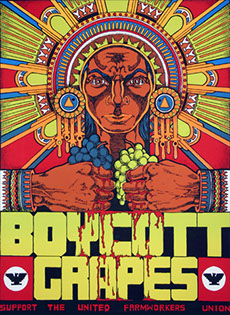

 Dolores Huerta’s half century of labor and civil rights activism is being recognized in a new exhibition at the Smithsonian Institution’s National Portrait Gallery (NPG) in Washington DC. Huerta is the first person of Latino heritage and only the second living American to be featured in its One Life exhibition series.
Dolores Huerta’s half century of labor and civil rights activism is being recognized in a new exhibition at the Smithsonian Institution’s National Portrait Gallery (NPG) in Washington DC. Huerta is the first person of Latino heritage and only the second living American to be featured in its One Life exhibition series.
Those exhibitions commemorate important historical anniversaries, in this case the 50th anniversary of the Delano Grape Strike, which brought national attention to the plight of migrant farm workers. César Chávez became the public face of the movement, but Huerta, who had co-founded what would become the United Farm Workers (UFW) with him, was its lobbyist and contract negotiator.
Taina Caragol, NPG’s curator of Latino art and history and organizer of the exhibition, explains that she chose to focus on Huerta because “Chávez is already in the history books, while Huerta, who was an important architect of the farm workers movement, is not as well known.” Huerta was instrumental in achieving major legal protections and a better standard of living for farm workers, Caragol notes. Museum director Kim Sajet underscores the importance of having “someone still with us to tell her story.”
Ever the activist, Huerta used the press conference opening the exhibition to advocate for farm workers, saying that she “had stood on the shoulders of many farm workers” and reminding those present that “they put food on our tables every single day.”
At 85, Huerta is still agitating for social change. She has led protesters at congressional offices, urging them to pass immigration reform. “The majority of people in California support it,” she says.
The exhibition, One Life: Dolores Huerta, chronicles the period from 1962, when she and Chávez co-founded UFW, until 1975, when the California Agricultural Labor Relations Act was passed. This was the first law of its kind in the United States, and granting farm workers in California the right to collectively organize and bargain for better wages and working conditions.
That may be what she is best known for, however, it is hardly the full extent of her career. At a time when organized labor was dominated by men, and Mexican American women were expected to dedicate themselves to family, Huerta advanced a new model of feminism; she was instrumental in achieving major legal protections and a better standard of living for farm workers, all while rearing 11 children.
Using both family and historical photographs, videos and iconic artifacts, the exhibition tells, by turns, a personal and political story. Huerta’s empathy for the farm workers started early: She grew up in Stockton, the center of California’s migrant farming community made famous in John Steinbeck’s The Grapes of Wrath. During World War II, her mother ran a hotel in Stockton, California, and often provided free lodging to migrant workers. After getting a degree in education, Huerta worked for the Community Services Organization (CSO), an early self-help organization for Mexican Americans, where Chávez was her supervisor. They left CSO because of its emphasis on urban issues, and formed the National Farm Workers Association.
Although the grape strike and the UFW itself are commonly associated with Mexican American migrant workers, the exhibition documents that the movement crossed ethnic lines. The Filipino Agricultural Workers Organizing Committee became an integral part of the union, which in turn was joined by African American, Puerto Rican and even Yemeni workers!
Among the most eye-catching objects on display are the red, white and black UFW flag and a Boycott Grapes poster that epitomizes Chicano art. A photograph of Huerta wearing a sweater knitted with the UFW logo that was given to her by a supporter is displayed next to the sweater itself. Concluding the exhibition is the Medal of Freedom, the nation’s highest civilian honor, that President Obama presented to Huerta in 2012.
Huerta is not the only Latino currently spotlighted at the National Portrait Gallery: Caragol was also part of the curatorial team for another new NPG exhibition, Eye Pop: The Celebrity Gaze, which displays new acquisitions to examine 21st century celebrity and achievements. Among the Latinos featured in the exhibition are Supreme Court Justice Sonia Sotomayor, actor John Leguizamo, author Sandra Cisneros, architect Cesar Pelli, and baseball player Albert Pujols.
One Life: Dolores Huerta will be on display at the Smithsonian Institution’s National Portrait Gallery in Washington, D.C. through May 15, 2016.
John Coppola